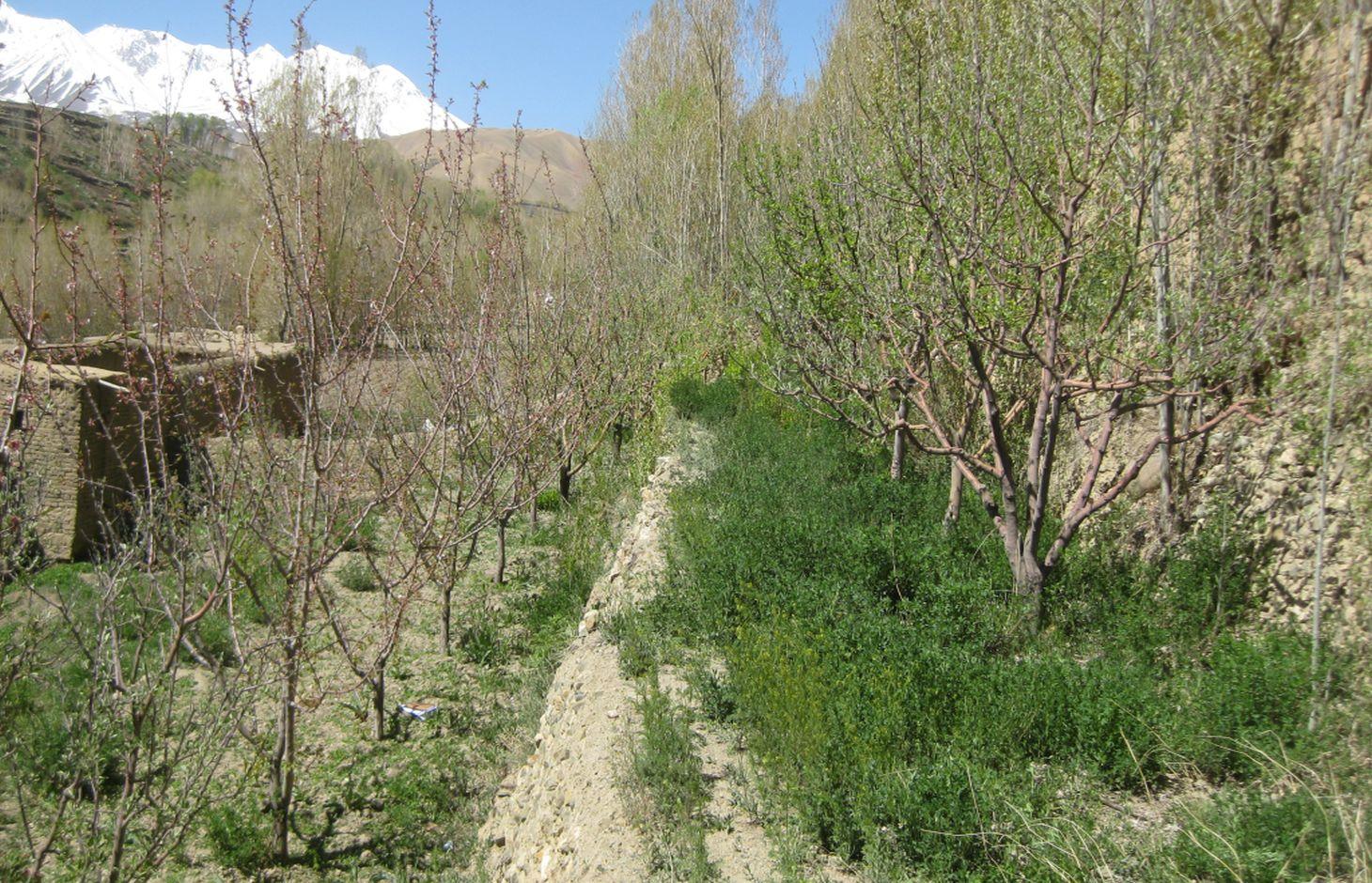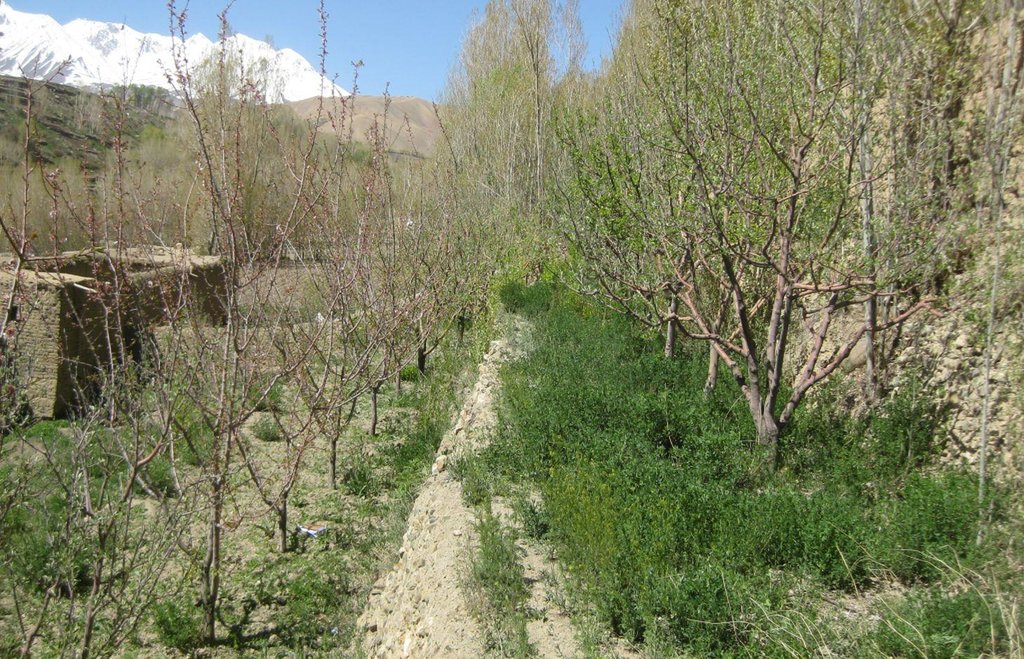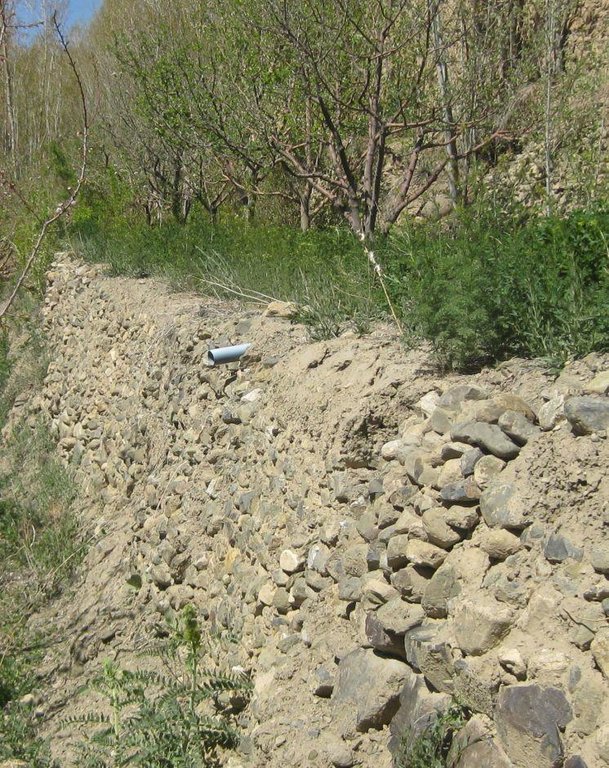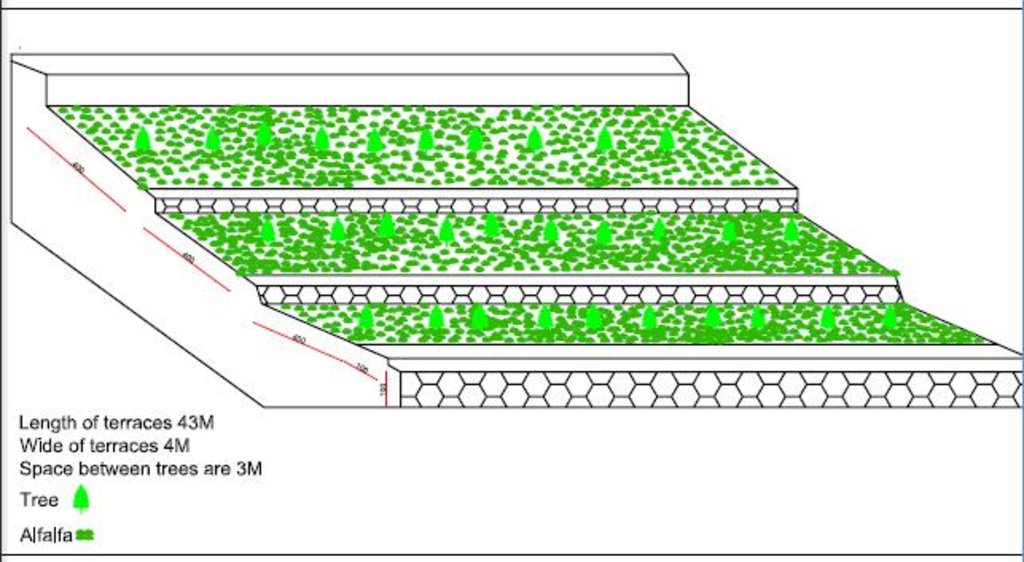Alfalfa intercropping in terraced fruit orchard [أفغانستان]
- تاريخ الإنشاء:
- تحديث:
- جامع المعلومات: Aqila Haidery
- المحرر: –
- المُراجع: David Streiff
Baghe Tabaqabandi
technologies_1198 - أفغانستان
عرض الأقسام
توسيع الكل طي الكل1. معلومات عامة
1.2 تفاصيل الاتصال بالأشخاص الرئيسيين لمصدر المعلومات والمؤسسات المشاركة في تقييم وتوثيق التقنية
متخصص في الإدارة المستدامة للأراضي:
متخصص في الإدارة المستدامة للأراضي:
متخصص في الإدارة المستدامة للأراضي:
متخصص في الإدارة المستدامة للأراضي:
متخصص في الإدارة المستدامة للأراضي:
Sthapit Keshar
HELVETAS Swiss Intercooperation
اسم المؤسسة (المؤسسات) التي سهلت توثيق/تقييم التقنية (إذا كان ذلك على صلة)
HELVETAS (Swiss Intercooperation)1.3 الشروط المتعلقة باستخدام البيانات الموثقة من خلال WOCAT
متى تم تجميع البيانات (ميدانيا)؟:
16/05/2014
يوافق جامع المعلومات والشخص (لاشخاص) الرئيسي لمصدر المعلومات على الشروط المتعلقة باستخدام البيانات الموثقة من خلال WOCAT:
نعم
2. وصف تقنيةالإدارة المستدامي للأراضي
2.1 وصف مختصر للتقنية
تعريف التقنية:
Terraced orchard with alfalfa cultivation for fruit and fodder production and soil and water conservation.
2.2 وصف تفصيلي للتقنية
الوصف:
The Alfalfa inter-cropping in terraced fruit orchard technology is documented by Sustainable Land Management Project/HELVETAS Swiss Intercooperation with financial support of Swiss Agency for Development and Cooperation (SDC).
In the semi-arid regions of the Central Highlands in Afghanistan, land is intensively used for the
cultivation of subsistence (wheat) and cash crops. The technology presented here provides an economically sound solution for soil and water conservation. In this example, Alfalfa is grown in the spaces between the young trees to make use of the soil, light and water. The soil and water conservation quality of the technology is further enhanced with terracing to capture water.
Purpose of the Technology: The main purpose of establishing the fruit orchard with Alfalfa was to produce fruits for both
consumption and income, as well as for animal fodder. Terraces are important for retaining soil moisture, reducing soil erosion and preventing nutrient leaching. Alfalfa increases soil fertility as it fixes
nitrogen.
Establishment / maintenance activities and inputs: The area under this specific technology is less than 0.03 ha. The technology was established by the land user five years ago without external support. In the past, the site was sloping agriculture land used for potato and wheat cultivation, the two major staple crops in Bamyan. Animal manure, with small quantities of chemical fertilizers, were used to maintain the soil fertility. The farmer, Haji Hussain, learning from similar examples from Kabul, applied this technology on his private land
with sight modifications by including terraces for soil and water conservation. For the construction of one terrace, 14 person days are needed. The size of one terrace was about 43 m in length and 4 m in width.Initially the terraces were used for vegetable cultivation. Later on, he planted mainly apple and apricot trees and a few saplings of pear and plum. Two varieties of apple (red and yellow) were planted in the orchard and the distance between two trees in a row was about 3 m (for more details, please see the technical drawing). The saplings were prepared by the farmer himself using grafting. The trees vary in age, from 3-5 years. Alfalfa was planted 1-3 years ago. The farmer applies 1 kg urea and DAP per tree every spring in addition to a small quantities of manure. The orchard requires irrigation almost every week from mid-spring to autumn from a nearby canal. The water distribution and operation and maintenance of the irrigation infrastructure is regulated by a Mirab, or “Water Master”, elected by the water users and farmers.
Natural / human environment: Bamyan Center has temperate and semi-arid climate with an average annual rainfall of about 230 mm. The area receives snow during the winter season and the temperature can drop below -20 degree centigrade.There is one growing season from April to September. The soil in the orchard is sandy loam with moderate soil fertility. Orchards are considered to be more profitable by the land user than growing crops like wheat and potato. Before applying this technology, the average annual income of the owner from 0.3 ha land was 9,000 Afghani, equivalent to approx 180 USD. While after the application of terraced orchard with Alfalfa cultivation technology, his average annual income from 0.3 ha increased to 45000 Afghani or 900 USD.
2.3 صور التقنية
2.5 البلد/المنطقة/المواقع التي تم تنفيذ التقنية فيها والتي يغطيها هذا التقييم
البلد:
أفغانستان
المنطقة/الولاية/المحافظة:
Bamyan
مزيد من التفاصيل حول الموقع:
Bamyan Centre / Shinya Fuladi
2.6 تاريخ التنفيذ
في حالة عدم معرفة السنة بالتحديد، يرجى الإشارة إلى التاريخ التقريبي:
- منذ 10-50 سنة
2.7 إدخال التقنية
حدد كيف تم إدخال التقنية:
- من خلال ابتكار مستخدمي الأراضي
التعليقات (نوع المشروع، الخ):
The farmers learnt this technology by seeing others apply it.
3. تصنيف تقنية الإدارة المستدامي للأراضي
3.1 الغرض الرئيسي ( الأغراض الرئيسية) للتقنية
- تحسين الإنتاج
- الحد من تدهور الأراضي ومنعه وعكسه
- خلق أثر اقتصادي مفيد
3.2 نوع (أنواع) استخدام الأراضي الحالية حيث يتم تطبيق التقنية

الأراضي الزراعية
- زراعة سنوية
- زراعة معمرة (غير خشبية)
- زراعة الأشجار والشجيرات
المحاصيل الرئيسية (المحاصيل النقدية والغذائية):
major cash crop: Apple and Apricot
major food crop: Wheat and Potato
other: Alfalfa

أراضي الرعي
الرعي المكثف/ إنتاج الأعلاف:
- قطع وحمل / صفر مرعى
- مراعي محسنة
التعليقات:
Major land use problems (compiler’s opinion): In the past, the orchard site was a sloping land and used for cultivating wheat and potato without soil and water conservation measures. This resulted in soil erosion, soil fertility decline and low crop production.
Major land use problems (land users’ perception): Due to sloping land, most of the animal manure applied to the crops used to get leached affecting crop production.
Future (final) land use (after implementation of SLM Technology): Cropland: Ct: Tree and shrub cropping
إذا تغير استخدام الأراضي بسبب التقنية، قم بالإشارة إلى استخدام الأرض قبل تنفيذ التقنية:
Cropland: Ca: Annual cropping
3.3 مزيد من المعلومات حول استخدام الأراضي
إمدادات المياه للأرض التي يتم تنفيذ التقنية عليها:
- ري كامل
عدد مواسم الزراعة في السنة:
- 1
حدد:
Longest growing period in days: 180; Longest growing period from month to month: April-September
3.4 مجموعةالإدارة المستدامة للأراضي التي تنتمي إليها هذه التقنية
- أنظمة التناوب (تعاقب المحاصيل، البور، الزراعة المتنقلة)
- التدابير المتقاطعة للمنحدرات
3.5 انتشار التقنية
التعليقات:
Total area covered by the SLM Technology is 0.0003 km2.
Alfalfa is cultivated in apple and apricot mixed terraced orchard for multiple benefits.
3.6 التدابير التقنية في مجال إلادارة المستدامة للأراضي

التدابير النباتية
- V5: أخرى

التدابير البنيوية
- S1: المصاطب المتدرجة
التعليقات:
Specification of other vegetative measures: fruit trees and alfalfa
Type of vegetative measures: aligned: -linear, scattered / dispersed
3.7 الأنواع الرئيسية من تدهور الأراضي التي تناولتها التقنية

تآكل التربة بالمياه
- الوزن(Wt): فقدان التربة السطحية/تآكل السطح

التدهور الكيميائي للتربة
- (Cn): تراجع الخصوبة وانخفاض محتوى المادة العضوية (غير ناتج عن الانجراف)
التعليقات:
Main type of degradation addressed: Wt: loss of topsoil / surface erosion, Cn: fertility decline and reduced organic matter content
Main causes of degradation: soil management (Agriculure on sloping land without conservation measures), disturbance of water cycle (infiltration / runoff) (Due to sloping land), education, access to knowledge and support services (Lack of knowledge about sloping agriculture land soil and water conservation technologies)
3.8 منع أو حد أو عكس تدهور الأراضي
تحديد هدف التقنية فيما يتعلق بتدهور الأراضي:
- الحد من تدهور الأراضي
4. المواصفات الفنية، وأنشطة التنفيذ، والمدخلات، والتكاليف
4.1 الرسم الفني للتقنية
4.2 المواصفات الفنية/شروحات الرسم الفني
Layout of the terraced fruit orchard with alfalfa crop.
Location: Shenya, Foladi valley. Bamyan
Date: 14.06.2016
Technical knowledge required for land users: moderate
Main technical functions: control of dispersed runoff: impede / retard, reduction of slope angle, reduction of slope length, improvement of ground cover, promotion of vegetation species and varieties (quality, eg palatable fodder)
Aligned: -linear
Vegetative material: F : fruit trees / shrubs
Number of plants per (ha): 800
Vertical interval between rows / strips / blocks (m): 1
Spacing between rows / strips / blocks (m): 1.3
Vertical interval within rows / strips / blocks (m): 2.5
Scattered / dispersed
Vegetative material: C : perennial crops
Width within rows / strips / blocks (m): 3.5
Trees/ shrubs species: Apple and Apricot
Perennial crops species: Alfalfa
If the original slope has changed as a result of the Technology, the slope today is (see figure below): 2%
Terrace: bench level
Width of bunds/banks/others (m): 4
Length of bunds/banks/others (m): 43
Bund/ bank: graded
Vertical interval between structures (m): 1
Spacing between structures (m): 1.3
Construction material (earth): for making terraces
Construction material (stone): for making risers
If the original slope has changed as a result of the Technology, the slope today is: 2%
Change of land use type: Conversion of annual cropland into perennial fruit orchard with perennial fodder crop
4.3 معلومات عامة بخصوص حساب المدخلات والتكاليف
عملة أخرى/ عملة وطنية (حدد):
Afghani
أشر إلى سعر الصرف من الدولار الأمريكي إلى العملة المحلية (إذا كان ذا صلة): 1 دولار أمريكي =:
57,0
اذكر متوسط تكلفة أجر العمالة المستأجرة في اليوم الواحد:
400
4.4 أنشطة التأسيس
| النشاط | نوع التدبير | التوقيت | |
|---|---|---|---|
| 1. | Plantation of saplings | نباتية | Late Autumn or early spring |
| 2. | Plantation of alfalfa | نباتية | early spring |
| 3. | Construction of terraces | بنيوية أو هيكلية | Dry season |
4.5 التكاليف والمدخلات اللازمة للتأسيس
| تحديد المدخلات | الوحدة | الكمية | التكاليف لكل وحدة | إجمالي التكاليف لكل مدخل | % من التكاليف التي يتحملها مستخدمو الأراضي | |
|---|---|---|---|---|---|---|
| العمالة | Construction of terraces | persons/day/ha | 400,0 | 400,0 | 160000,0 | 100,0 |
| المواد النباتية | Plantation of saplings | pieces/ha | 800,0 | 150,0 | 120000,0 | 100,0 |
| المواد النباتية | Plantation of alfalfa | kg/ha | 100,0 | 250,0 | 25000,0 | 100,0 |
| إجمالي تكاليف إنشاء التقنية | 305000,0 | |||||
4.6 الصيانة/الأنشطة المتكررة
| النشاط | نوع التدبير | التوقيت/الوتيرة | |
|---|---|---|---|
| 1. | Fertilizer application only | نباتية | Spring |
4.7 التكاليف والمدخلات اللازمة للصيانة/للأنشطة المتكررة (سنويًا)
| تحديد المدخلات | الوحدة | الكمية | التكاليف لكل وحدة | إجمالي التكاليف لكل مدخل | % من التكاليف التي يتحملها مستخدمو الأراضي | |
|---|---|---|---|---|---|---|
| الأسمدة والمبيدات الحيوية | Fertilizer application only | kg/ha | 800,0 | 16,0 | 12800,0 | 100,0 |
| إجمالي تكاليف صيانة التقنية | 12800,0 | |||||
التعليقات:
The costs are extrapolated for 1 ha. Current (2014) labour and currency exchange rates were used for calculations.
4.8 أهم العوامل المؤثرة على التكاليف
قدم وصفا لأهم العوامل التي تؤثر على التكاليف:
Labour for construction work is the most determinate factor affection costs.
5. البيئة الطبيعية والبشرية
5.1 المناخ
هطول الأمطار السنوي
- < 250 مم
- 251- 500 ملم
- 501 - 750ملم
- 1,000-751 ملم
- 1,500-1,100 ملم
- 2,000-1,500 ملم
- 3,000-2,001 ملم
- 4,000-3,100 ملم
- > 4000 ملم
حدد متوسط هطول الأمطار السنوي (إذا كان معروفًا)، بالملليمتر:
230,00
المواصفات/التعليقات على هطول الأمطار:
Most rainfall is recorded in the months of April and May. Rainy season begins in April and ends in June.
المنطقة المناخية الزراعية
- شبه قاحلة
Thermal climate class: temperate. Temperatures can drop to below -22 degree centigrade
5.2 طوبوغرافيا
متوسط الانحدارات:
- مسطح (0-2%)
- بسيط (3-5%)
- معتدل (6-10%)
- متدحرج (11-15%)
- تلال (16-30%)
- شديدة الانحدار(31-60%)
- فائقة الانحدار (>60%)
التضاريس:
- هضاب/سهول
- أثلام مرتفعة
- المنحدرات الجبلية
- منحدرات التلال
- منحدرات في السفوح
- قاع الوادي
المنطقة الارتفاعية:
- 100-0 متر فوق سطح البحر
- 500-101 متر فوق سطح البحر
- 1,000-501 متر فوق سطح البحر
- 1,500-1,001 متر فوق سطح البحر
- 2,000-1,501 متر فوق سطح البحر
- 2,500-2,100 متر فوق سطح البحر
- 3,000-2,501 متر فوق سطح البحر
- 4,000-3,001 متر فوق سطح البحر
- > 4000 متر فوق سطح البحر
التعليقات والمواصفات الإضافية بشأن التضاريس:
Landforms: Level terraces
Altitudinal zone: About 2600 m above mean sea level
5.3 التربة
متوسط عمق التربة:
- ضحل جدًا (0-20 سم)
- ضحلة (21-50 سم)
- متوسطة العمق (51-80 سم)
- عميقة (81-120 سم)
- عميقة جدًا (> 120 سم)
قوام التربة (التربة السطحية):
- خشن / خفيف (رملي)
- متوسط ( طميي، سلتي)
المواد العضوية في التربة السطحية:
- متوسطة (1-3%)
إذا كان متاحًا، قم بإرفاق وصف كامل للتربة أو تحديد المعلومات المتوفرة، على سبيل المثال نوع التربة، الرقم الهيدروجيني/ درجة حموضة التربة، قدرة التبادل الكاتيوني، النيتروجين، الملوحة وما إلى ذلك.
Soil fertility is medium due to use of manure, fertilizer and also alfalfa
Soil drainage / infiltration is good due to vegetation
Soil water storage capacity is medium
5.4 توافر المياه ونوعيتها
منسوب المياه الجوفية:
50-5 م
توافر المياه السطحية:
جيد
نوعية المياه (غير المعالجة):
للاستخدام الزراعي فقط (الري)
تعليقات ومواصفات أخرى بشأن نوعية المياه وكميتها:
Availability of surface water: Access to irrigation water canal
Water quality (untreated): From the canal.
5.5 التنوع البيولوجي
تنوع الأنواع:
- منخفض
5.6 خصائص مستخدمي الأراضي الذين يطبقون التقنية
التوجه السوقي لنظام الإنتاج:
- مختلط (كفاف/ تجاري)
الدخل من خارج المزرعة:
- 10-50% من جميع الإيرادات
المستوى النسبي للثروة:
- ثري
أفراداً أو مجموعات:
- فرد/أسرة معيشية
مستوى المكننة:
- عمل يدوي
الجنس:
- رجال
اذكر الخصائص الأخرى ذات الصلة لمستخدمي الأراضي:
Land users applying the Technology are mainly common / average land users
Difference in the involvement of women and men: Many works concerning orchard maintenance and harvesting are done by women as well.
Population density: 10-50 persons/km2
Annual population growth: 2% - 3%
Off-farm income specification: Mainly land users with large irrigated agriculture land holdings. The majority of the population has less than 1 ha land thus off-farm income seems to be very important.
Level of mechanization: He performed with his son and family
5.7 متوسط مساحة الأرض المملوكة أو المستأجرة من قبل مستخدمي الأراضي الذين يطبقون التقنية
- < 0.5 هكتارا
- 0.5 - 1 هكتار
- 1 -2 هكتار
- 2 - 5 هكتار
- 5 - 15 هكتار
- 15 - 50 هكتار
- 50 - 100هكتار
- 500-100 هكتار
- 1,000-500 هكتار
- 10,000-1,000 هكتار
- > 10,000 هكتار
هل يعتبر هذا نطاقًا صغيرًا أو متوسطًا أو واسعا (في إشارة إلى السياق المحلي)؟:
- على نطاق واسع
التعليقات:
2-5 ha: This applies to a very small extent of the population like this land user
5.8 ملكية الأراضي، وحقوق استخدام الأراضي، وحقوق استخدام المياه
ملكية الارض:
- فردية، يوجد سند ملكية
حقوق استخدام الأراضي:
- فردي
حقوق استخدام المياه:
- مجتمعي (منظم)
التعليقات:
Water use rights are common and organised. The village has access to sufficient irrigation water throughout the year.
5.9 الوصول إلى الخدمات والبنية التحتية
الصحة:
- ضعيف
- معتدل
- جيد
التعليم:
- ضعيف
- معتدل
- جيد
المساعدة التقنية:
- ضعيف
- معتدل
- جيد
العمل (على سبيل المثال خارج المزرعة):
- ضعيف
- معتدل
- جيد
الأسواق:
- ضعيف
- معتدل
- جيد
الطاقة:
- ضعيف
- معتدل
- جيد
الطرق والنقل:
- ضعيف
- معتدل
- جيد
مياه الشرب وخدمات الصرف الصحي:
- ضعيف
- معتدل
- جيد
الخدمات المالية:
- ضعيف
- معتدل
- جيد
6. الآثار والتصريحات الختامية
6.1 الآثار التي أظهرتها التقنية في الموقع
الآثار الاجتماعية والاقتصادية
الإنتاج
إنتاج المحاصيل
الكمية قبل الإدارة المستدامة للأراضي:
0
الكمية بعد الإدارة المستدامة للأراضي:
420 kg
التعليقات/ حدد:
Fruit production
إنتاج الأعلاف
التعليقات/ حدد:
Alfalfa
جودة العلف
التعليقات/ حدد:
Alfalfa
إنتاج حيواني
التعليقات/ حدد:
Due to alfalfa consumption
توليد الطاقة
التعليقات/ حدد:
Pruned twigs can be used for firewood
الدخل والتكاليف
دخل المزرعة
الكمية قبل الإدارة المستدامة للأراضي:
10,000 Afghani
الكمية بعد الإدارة المستدامة للأراضي:
45,000 Afghani
الآثار الاجتماعية والثقافية
الأمن الغذائي / الاكتفاء الذاتي
التعليقات/ حدد:
Due to more income and production
الفرص الترفيهية
التعليقات/ حدد:
Due to greenery and sound of birds.
المعرفة بالإدارة المستدامة للأراضي/تدهور الأراضي
التعليقات/ حدد:
Farmer to farmer knowledge exchange
livelihood and human well-being
التعليقات/ حدد:
The technology help in increased income which can be used for buying food. Families consume more and a greater variety of foods which is beneficial for health.
الآثار الايكولوجية
التربة
غطاء التربة
فقدان التربة
التنوع البيولوجي: الغطاء النباتي، الحيوانات
التنوع النباتي
التعليقات/ حدد:
More species, cultivated and natural
التنوع الحيواني
التعليقات/ حدد:
E.g. Birds
6.2 الآثار التي أظهرتها التقنية خارج الموقع
تلوث المياه الجوفية/الأنهار
القدرة على التخفيف / الترشيح
6.3 تعرض التقنية وحساسيتها لتغير المناخ التدريجي والظواهر المتطرفة/الكوارث المرتبطة بالمناخ (كما يراها مستخدمو الأراضي)
تغير مناخ تدريجي
تغير مناخ تدريجي
| الموسم | نوع التغير المناخي/ المتطرف | كيف تتعامل التقنية مع ذلك؟ | |
|---|---|---|---|
| درجة الحرارة السنوية | زيادة | غير معروف |
العواقب الأخرى المتعلقة بالمناخ
العواقب الأخرى المتعلقة بالمناخ
| كيف تتعامل التقنية مع ذلك؟ | |
|---|---|
| Fruit tress are sensitive to frost | ليس جيدا |
6.4 تحليل التكلفة والعائد
كيف يمكن مقارنة العوائد نسبة لتكاليف الإنشاء (من وجهة نظر مستخدمي الأراضي)؟
عوائد قصيرة الأجل:
سلبي
عوائد طويلة الأجل:
ايجابي جدا
كيف تتم مقارنة العوائدمع كلفة الصيانة/التكاليف المتكررة (من وجهة نظر مستخدمي الأراضي)؟
عوائد قصيرة الأجل:
سلبي قليلا
عوائد طويلة الأجل:
ايجابي جدا
6.5 اعتماد التقنية
- حالات فردية/تجريبية
إذا كان متاحًا، قم بتحديد الكمية (عدد الأسر المعيشية و/أو المساحةالمغطاة):
1 household
من بين جميع الذين تبنوا التقنية، كم عدد الذين فعلوا ذلك بشكل تلقائي، أي دون تلقي أي حوافز مادية/مدفوعات؟:
- 100-90%
التعليقات:
1 land user families have adopted the Technology without any external material support
Comments on spontaneous adoption: There are other 20 land user families in the region who has applied this technology.
There is a little trend towards spontaneous adoption of the Technology
Comments on adoption trend: There is a small but growing trend towards spontaneous adoption of the technology among farmers with access to irrigated lands.
6.7 نقاط القوة / المزايا / الفرص التي توفرها التقنية
| نقاط القوة/ المزايا/ الفرص من وجهة نظر مستخدمي الأراضي |
|---|
|
The technology has multiple benefits and needs less labour inputs. How can they be sustained / enhanced? The technology system can be enhanced by including honeybee keeping. |
| نقاط القوة/ المزايا/ الفرص من وجهة نظر جامع المعلومات أو غيره من الاشخاص الرئيسيين لمصدر المعلومات |
|---|
|
Reduced soil erosion and improved water management compared to sloping agricultural land. How can they be sustained / enhanced? Efficient use of water by the application of mulching and pitcher irrigation. Use of well decomposed compost for increasing production and reinforcement of soil quality. Reduced usage of chemical fertilizer. |
|
The technology can be easily applied. How can they be sustained / enhanced? Exposure visit of farmers to improved orchard cultivation practices. |
|
Including perennial fodder crop like alfalfa has multiple benefits. How can they be sustained / enhanced? Alalfa is a water demanding crop. Other nitrogen perennial high quality perennial crops like sainfoin could be tried by the farmer. |
|
The demand for fruits is high, therefore, it contributes to the increased income of the farmers. How can they be sustained / enhanced? Production could be increased through better orchard management. Farmers may need training and information on improved methods through agriculture extension departments and concerned non-governmental organisations. |
6.8 نقاط ضعف / مساوىء / مخاطر التقنية وسبل التغلب عليها
| نقاط الضعف/ المساوىء/ المخاطر من وجهة نظر مستخدم الأراضي | كيف يمكن التغلب عليها؟ |
|---|---|
| Fruit trees are sensitive to frost. | Relevant research organisations need to develop tolerant varieties through participatory technology approach. Sharing better practices from other countries may be useful. |
| نقاط الضعف/ المساوىء/ المخاطر من وجهة نظر جامع المعلومات أو غيره من الاشخاص الرئيسيين لمصدر المعلومات | كيف يمكن التغلب عليها؟ |
|---|---|
| The technology depends on a constant supply of irrigation water. | Demonstration of improved orchards with a focus on water conservation and soil nutrient management (use of compost, mulch, pitcher irrigation, etc.) |
الروابط والوحدات المواضيعية
توسيع الكل طي الكلالروابط
لا يوجد روابط
الوحدات المواضيعية
لا يوجد وحدات مواضيعية





